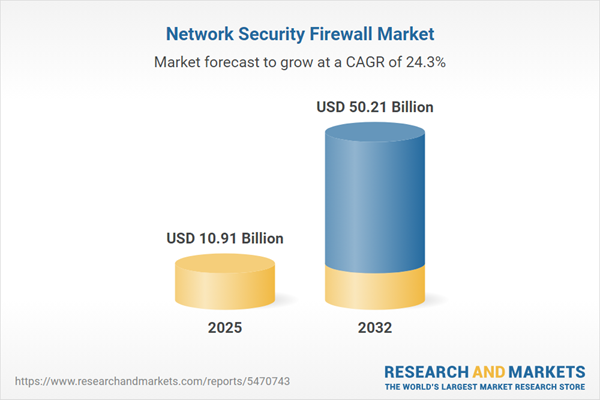Speak directly to the analyst to clarify any post sales queries you may have.
Network security firewall solutions are fundamental for safeguarding enterprise environments as organizations embrace cloud, hybrid, and distributed architectures. Strategic alignment of firewall programs is essential for operational resilience, policy consistency, and efficient risk management at scale.
Market Snapshot: Network Security Firewall Market
The network security firewall market grew from USD 8.81 billion in 2024 to USD 10.91 billion in 2025, and is projected to maintain a compound annual growth rate (CAGR) of 24.29%, reaching USD 50.21 billion by 2032.
Expansion is driven by increased adoption of hybrid and cloud-native infrastructures, as well as heightened demand for robust threat prevention and integrated management capabilities.Scope & Segmentation of Analysis
This report delivers an in-depth evaluation of the network security firewall ecosystem, spanning deployment models, technology components, organizational scales, industry verticals, and global regions. The analysis supports executive teams prioritizing procurement, architecture, and compliance strategy.
- Deployment Modes: Cloud based; On premises
- Components: Hardware firewall; Services; Software firewall
- Organization Sizes: Large enterprises; Small and medium enterprises
- Industry Verticals: Banking, financial services, and insurance (BFSI); Energy and utilities; Government and defense; Healthcare; IT and telecom; Manufacturing; Retail and e-commerce
- Regions: Americas (United States, Canada, Mexico, Brazil, Argentina, Chile, Colombia, Peru); Europe, Middle East & Africa (United Kingdom, Germany, France, Russia, Italy, Spain, Netherlands, Sweden, Poland, Switzerland, United Arab Emirates, Saudi Arabia, Qatar, Turkey, Israel, South Africa, Nigeria, Egypt, Kenya); Asia-Pacific (China, India, Japan, Australia, South Korea, Indonesia, Thailand, Malaysia, Singapore, Taiwan)
- Vendor Coverage: Fortinet, Palo Alto Networks, Cisco, Check Point, Juniper Networks, Sophos, Hillstone Networks, Huawei, Forcepoint, Barracuda Networks
Key Takeaways for Senior Decision-Makers
- Firewall programs must evolve beyond single-product implementations, integrating with identity management, cloud governance, and segmentation policies to address expanding attack surfaces.
- Technology convergence—such as packet inspection combined with contextual awareness and threat intelligence—significantly enhances detection and response capabilities across hybrid environments.
- Operational priorities now focus on centralized policy management, automation, and alignment with orchestration platforms, resulting in faster, more consistent threat mitigation.
- Procurement dynamics are shifting toward flexible, outcome-oriented solutions, with growing adoption of subscription and managed service models suitable for both large enterprises and SMEs.
- Regional and industry-specific compliance requirements demand adaptable architectures and strong partnerships with local and global vendors to guarantee auditability and data sovereignty.
Tariff Impact on Firewall Procurement
Recent tariff changes in the United States have influenced procurement behaviors, supply chain strategies, and the pace of software-based firewall adoption. Many organizations have shifted to software-defined and cloud-native alternatives, reducing dependency on physical hardware shipments and mitigating the risks associated with variable costs and supply chain delays. This period accelerated the trend toward regional manufacturing and diversified sourcing, while encouraging tighter collaboration between security, procurement, and logistics teams. Vendors have also adapted by enhancing managed services and prioritizing software delivery in response to evolving procurement needs.
Methodology & Data Sources
The research applies a mixed-methods approach, combining structured interviews with security and procurement leaders, comprehensive product capability analysis, and review of regulatory and technical documentation. Data triangulation reinforces insights, ensuring actionable and reliable guidance for executive decision-making.
Why This Report Matters
- Delivers actionable segmentation intelligence, highlighting how deployment model, organizational scale, and vertical specialization drive firewall investment strategies.
- Reveals how evolving technology and commercial models influence procurement agility, enabling security leaders to optimize for regulatory changes and business needs.
- Equips executives with clear, data-backed recommendations that translate directly to improved security posture and measurable operational outcomes.
Conclusion
Firewall strategy is becoming programmatic, prioritizing policy-driven operations, automation, and supply chain resilience across diverse environments. Executives who adopt modular, outcome-focused solutions position their organizations for sustainable risk reduction and enhanced agility in a dynamic threat landscape.
Additional Product Information:
- Purchase of this report includes 1 year online access with quarterly updates.
- This report can be updated on request. Please contact our Customer Experience team using the Ask a Question widget on our website.
Table of Contents
3. Executive Summary
4. Market Overview
7. Cumulative Impact of Artificial Intelligence 2025
Companies Mentioned
The companies profiled in this Network Security Firewall market report include:- Fortinet, Inc.
- Palo Alto Networks, Inc.
- Cisco Systems, Inc.
- Check Point Software Technologies Ltd.
- Juniper Networks, Inc.
- Sophos Ltd.
- Hillstone Networks, Inc.
- Huawei Technologies Co., Ltd.
- Forcepoint LLC
- Barracuda Networks, Inc.
Table Information
| Report Attribute | Details |
|---|---|
| No. of Pages | 186 |
| Published | October 2025 |
| Forecast Period | 2025 - 2032 |
| Estimated Market Value ( USD | $ 10.91 Billion |
| Forecasted Market Value ( USD | $ 50.21 Billion |
| Compound Annual Growth Rate | 24.2% |
| Regions Covered | Global |
| No. of Companies Mentioned | 11 |









